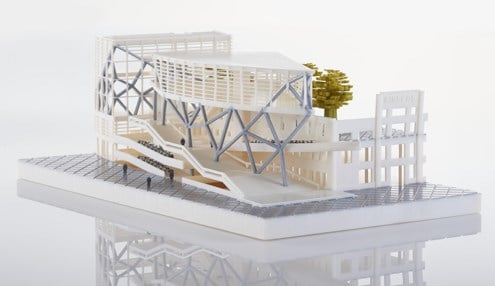Photopolymers utilized in 3D printing offer fine feature detail along with a final-product aesthetic realism unmatched by other technologies. With prototypes and concept models, simulating cosmetics and feel of the end-product is often essential. That’s where photopolymers really shine. With little finishing needed, photopolymer technologies (such as PolyJet or Stereolithography) make aesthetic parts rapidly, getting your idea into your hands and in front of your team that much quicker.
Photopolymers are thermoset materials, or polymers, that change properties when exposed to ultraviolet light. These materials can be clear or opaque, flexible and rigid, and can be specially formulated to accommodate unique application needs.
Suitable for models and prototypes that don’t require a long shelf-life, photopolymers have limited durability. They are not UV stable and can become discolored or deformed over time. These properties are essential considerations when working with photopolymers, but when testing a particular look or functionality of a prospective design, the material remains unmatched in fine detail and smooth finish. At Stratasys Direct, we offer a wide range of photopolymers for two technologies: PolyJet and Stereolithography.
PolyJet photopolymers have properties that range from rubber to rigid, transparent to opaque, neutral to full color. PolyJet technology also allows us to combine several materials in one model to fulfill specific requirements. We’re able to simulate over-molding with two different photopolymers to give prototypes exact product feel. Additionally, PolyJet prints in full color, adding another level of customization and possibilities for final product aesthetics.
PolyJet builds by jetting layers of liquid photopolymer as thin as 16 microns (0.0006”) layer by layer as a UV light cures simultaneously. PolyJet can print rigid and flexible materials in a single build to create over-molded parts without tooling. The technology delivers parts with shore hardness ranging from 27A-95A. Because PolyJet doesn’t require hard tooling to deliver an over-molded part, it is frequently used for prototypes requiring an elastomeric surface, such as grips or buttons, or for testing material hardness.
By blending two or three base resins to create nearly 1,000 composite materials with specific, predicable properties, PolyJet photopolymers expand your possibilities, because a range of hues, translucencies, Shore A values and other properties can be achieved for imaginative prototypes.
Stereolithography (SLA) photopolymers are epoxy or acrylate based resins that can create clear or opaque, strong and rigid parts. These materials mimic the properties of ABS, polycarbonate and polypropylene in layers as thin as 0.002”.
Stereolithography builds parts with a precise UV laser to cure and solidify thin layers of resin. Post-build, SLA parts require some support material removal and further UV curing, and other requested post-processing. Our finishing expertise can take your SLA prototypes and transform them into a replica of your finished product. Custom finishing, texture, color, artwork, EMI/RFI shielding, plating and other functional coatings can bring additional value to prototyping and models.
Stereolithography materials differ from PolyJet in that some offer higher impact resistance, heat deflection temperature and humidity resistance for functional prototyping or patterns. At Stratasys Direct, we offer a unique near-hollow build style with Stereolithography that allows us to build large concept models at the fraction of the weight. Use SLA photopolymers to build light, large-scale parts in much faster and at less cost with this method.
The ultimate benefit of building parts with PolyJet and SLA photopolymers is the ability to get your vision into your hands much faster than conventional manufacturing methods. PolyJet and SLA offer highly-cosmetic, sometimes large and extremely lightweight models delivered right on time.

